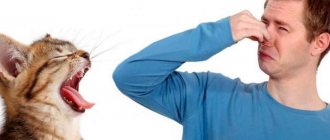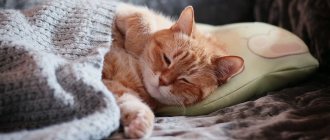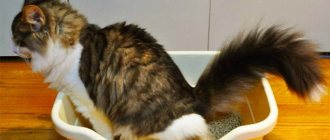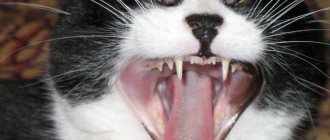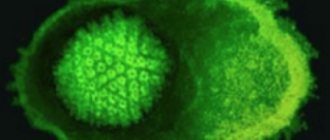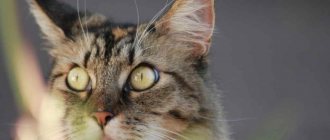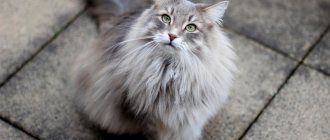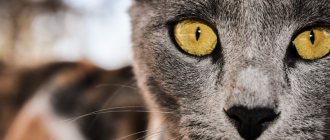What will you learn from the article?
- When cats shed
- The mechanism of shedding and its types Causes of shedding in cats
- Types of shedding
- Symptoms of shedding in cats
- Why is it important to remove dead hair?
- Reasons for increased shedding
- What substances are necessary for a cat's fur?
Shedding in cats is a natural process of fur renewal. All cat breeds shed without exception. Cats that do not shed at all do not exist in nature. There are breeds that shed less due to short hair or almost complete absence of it: sphinxes, elves, Peterbalds.
Every owner should know the causes and timing of shedding, the features of caring for the cat and home during the shedding period, and ways to reduce hair loss . We'll talk about all this in our material.
Shedding in kittens
At what age do kittens start shedding? Do they need to be combed out? Is shedding as big a problem as everyone says it is? About this and much more in our article.
Little kittens practically do not shed, since instead of fur they have baby soft fluff. However, caring for a kitten's coat, and brushing in particular, must begin from an early age. And there are a number of reasons for this:
- It is much easier to train a small kitten to be groomed than an adult cat. Kittens love affection and love contact with their owner, so careful brushing will be a pleasant pastime for them. Thus, even as an adult, your pet will have a positive attitude towards combing, and grooming will not turn into a life-or-death struggle for him.
- Brushing kittens from an early age helps prepare them for their first molt. The first molting of kittens is the most intense and long-lasting, because the babies have to exchange baby fluff for adult, coarser fur. And the task of every responsible owner is to help the pet in this difficult task (and also protect their things from fur). During the molting period, the kitten must be combed thoroughly and regularly. This way you will contribute to the renewal of the coat and reduce the number of hairs remaining on your things. A kitten already familiar with brushing will endure the first moult much easier and calmer than its less experienced brother.
When does kittens start shedding? – It depends on the season, breed and individual characteristics of the pet, but the average age for the first moult is 5-8 months. Renewing your kitten's fur will require additional nutrients: vitamins, amino and omega-3 fatty acids. Start giving your baby a complex with fish oil and brewer's yeast (for example, Excel Brewer's Yeast) from the first days of shedding, and you will see that the new coat will grow healthy and beautiful, and the first shedding will go much faster.
- Brushing is a necessary procedure for furry pets, otherwise their beautiful fur will begin to gather in tangles.
- Brushing is not only grooming, but also a kind of massage that improves blood circulation, which is very useful for kittens.
Brushing, like other pleasant joint activities, helps to tune in to a wave of mutual understanding and trust, which is very important in building a relationship between an owner and his four-legged friend.
How to brush a kitten?
It is very important that the combing procedure itself is carried out gently and carefully. Do not scare the kitten with sudden movements, do not forget to praise him and talk to him. The baby should perceive combing as affection and reverent self-care; his associations with grooming should be extremely pleasant.
The most effective assistants in training to groom are treats and voice intonation. Give your pet a treat while brushing and after it’s finished, and encourage him. By tasting goodies and hearing the gentle voice of the owner while grooming, the baby will associate grooming with something infinitely pleasant, which means our goal has been achieved!
To brush small kittens, it is enough to use special soft tools that will not injure the hair and skin (for example, the FURminator first grooming kit, which includes a soft slicker brush and a wide-tooth comb). Our goal in this case is not to remove dead undercoat (since it is not there yet), but to accustom the baby to the procedure itself.
In adolescence, after the first shedding, it is best to use the FURminator anti-shedding tool to remove dead undercoat. Why him?
To date, this is the most effective remedy for combating molting. The tool reduces the amount of lost hair by up to 90%, which is beyond the capabilities of analogues. Thanks to these results, FURminator gained enormous popularity, which provoked the mass production of counterfeits. Therefore, before purchasing an instrument, be sure to check its authenticity.
Thanks to high-quality hair care, pet shedding ceases to be a problem. See this in practice!
Make your pets happy, and let them make you happy in return!
Caring for a cat during shedding period
When a cat begins to shed, it needs special care. The animal needs to be combed daily. To speed up the process, you can give your cat professional grooming or use a furminator. In addition, it is important to more thoroughly clean the house of lost hair.
Why is it important to remove dead hair?
Villi that have fallen out and have not yet settled on your interior cause severe irritation and itching on the cat’s skin. The animal tries to lick off the excess fur or comb it out somehow.
Why is it dangerous:
- Once in the stomach, hairballs cause gastrointestinal upset and can lead to intestinal obstruction.
- Scratched wounds are entry points for infection. This can lead to various skin diseases in your pet.
- If allergy sufferers live in the house, then fur flying around the house can trigger an allergy attack.
Tips for caring for a cat during shedding
- Buy everything you need to comb out excess hair: combs, brushes or brush gloves. The choice will depend on the length of the coat and the breed of “our little brothers”.
- During this difficult period for the animal, take care of a special product (Malt-Soft paste) that helps remove hairballs from the body of the shedding comrade.
- Consult with your veterinarian which vitamins are best given during the shedding period to facilitate and reduce the shedding of your animal.
Should I bathe my cat while shedding?
There is an opinion that during the period of changing the cat’s fur, it is necessary to wash it so that it does not develop an allergy. After all, the main allergen is not wool, but particles of saliva remaining after the procedure of washing oneself with the tongue. They dry out and spread along with the dust. And washing helps speed up the process of replacing an old fur coat with a new one.
When do kittens start moulting?
Cats start shedding early. At about the age of six months, kittens begin to gradually change not only the structure, but the color of their fur. The duration of the first moult varies. Sometimes at least 6 months. During this time, the kitten sheds baby fluff, growing dense guard hairs. In point and multi-colored cats, the markings appear brighter. The appearance becomes complete.
You need to combat molting in a comprehensive manner. To begin with, support the kittens with vitamins and enhanced nutrition. In addition, this is a good opportunity to accustom your pet to hygiene procedures: combing and bathing. And simply smoothing your fur coat with a damp hand will not only be pleasant, but also useful.
Don't miss this moment: how well you take care of your kitten will determine the appearance of an adult cat in the future.
Winter molt
In winter, the lack of a headdress or the unnatural composition of the fabric from which it is made can become a stressful situation that affects the condition of the hair. The situation in winter is aggravated by dry indoor air, air conditioning, and frequent hair washing.
In winter, dry indoor air aggravates the situation.
How to help your hair
In winter, the first rule is to wear a hat - everyone knows this, but many people forget that the ends of the hair should always be under clothing or tucked completely under a hat. This rule must be strictly followed. A hat in winter should be made of natural material: wool, cotton, mohair - this will not only retain heat on the surface of the head, but also reduce the secretion of the sebaceous glands, which will eliminate the need to wash your hair.
Take care of your hair in all seasons, and it will repay you with its appearance and internal health.
Why and how cats shed
Subsequently, molting will become regular. For cats, this is a natural process of preparing for the change of season. Ideally, a cat sheds twice a year:
- before the cold weather begins. Reducing daylight hours and a significant decrease in temperatures include protective mechanisms that involve a change in wardrobe. Cats are rapidly growing a new coat that can protect them from frost. For example, the British grow a powerful, dense undercoat, which is much thicker than the summer one;
- before the onset of heat. Rising temperatures make it necessary to prepare for the summer heat. “Winter” fur, having served its purpose, is no longer needed. Therefore, a lightweight version is growing.
Cats that have free range react most strongly to the change of seasons. Their bodies are exposed to natural weather conditions and are sensitive to the changing seasons.
Cats living in an apartment without walking, despite the lack of seasonality in the home climate, also shed. Only the time of this process is not strictly tied to the environment. Depending on the breed, cats shed 1-2 times a year.
It should be borne in mind that in mature, uncastrated cats, shedding can begin at any time as a reaction to certain changes in physiology. This is how the body will react to hormonal changes during estrus or after kittens are weaned from mother's milk. This is not a reason to panic, you just need to provide your cat with improved nutrition and vitamins.
How to keep your house clean when your cat is shedding
When there is a shedding pet in the house, there will be fur on everything: carpets, sofas, furniture, floors, clothes. Some owners find this very annoying.
You should be patient and follow our tips for caring for a cat and cleaning the house.
- Brush your cat 1-2 times daily - this will collect dead hairs and the house will become cleaner.
- Vacuum your apartment daily, wipe down the furniture and wet clean the floor surface - this will prevent hair from rolling off and collecting on the furniture, near the walls and in the corners of the room.
- Use a damp towel to remove hair from upholstered furniture, carpeting and other surfaces.
- Buy a clothes cleaning roller with replaceable sticky surfaces. This roller is good for collecting wool from clothes, chairs and armchairs.
Of course, you will not be able to completely get rid of hair loss, since shedding is a natural process. But, you can reduce the amount of hair falling out and make your home cleaner.
How long does seasonal molting last?
If you are scared by your kitten's long first molt, don't worry. This is due to complex processes of physiological maturation. Shedding in cats that can be called adults goes back to normal. On average it lasts a couple of months a year. Once in the spring, and again at the end of autumn. There may be minor time shifts in the schedule.
Usually short-haired pets fit into the schedule and timing of shedding. It’s more difficult with the fluffier ones. Persians or Maine Coons, after shedding their guard hairs, take a long time to get rid of the undercoat. They definitely won't be able to do it without your help. If you don't help them with their struggle, the consequences can be serious. From local tangles to completely matted fur.
Sometimes shedding in cats occurs unplanned or does not stop for a long time.
How to speed up and reduce?
It is impossible to completely stop the process of hair loss. But you can speed it up. This will help your pet recover as quickly as possible.
- An essential condition is daily combing of the coat.
- To speed up hair renewal, washing your dog in warm water using protein shampoo or a special product for animals during the molting period will help. After washing your pet, you need to wrap it in a towel for 1-2 hours. It is important to carefully monitor its condition to prevent overheating. Then the animal must be thoroughly combed. This will speed up the molting process, but you should not resort to this method too often.
- If you want to improve the condition of the coat, it is important your pet properly During this period, the dog spends a lot of energy on the formation of new hair. A complex of vitamins and a balanced diet will help the animal maintain health.
- You can add vegetable oils or fish oil at the rate of 1 teaspoon per 4.5 kg of body weight. Once a week you can give fillets of sea fish.
Mud fight: how often and with what can you wash your dog?
Reasons for intense year-round shedding
Considering that shedding in cats is a natural physiological process, it is important to understand when it goes beyond the normal. If fur falls out intensively for more than a month, especially out of season, and without objective prerequisites, this is a reason to think about the reasons for what is happening.
Usually a cat sheds a lot:
- During illness. It doesn't matter if there is an internal disease or the cause is on the surface of the body, shedding in cats is an indicator of health. In normal condition, fluff does not fly in different directions. Moreover, you can suspect anything: from banal vitamin deficiency or allergies to serious diseases of internal organs. Only specialists will carry out competent diagnostics. You should not self-medicate, as you will only make the problems worse.
- Unsuitable care products. If health is not suspicious: tests are normal, behavior is active, and shedding does not stop, this is a reason to change the shampoo, at a minimum. Ideally, change all cosmetics for the cat. You may be using the wrong brush. Pay attention to what accessories are recommended by breeders and veterinarians for each specific breed separately for everyday care and for the molting period.
- Errors in feeding. Often the reasons for year-round molting are in the food. Natural food must be prepared according to special recipes that provide an ideal balance of nutrients. Be sure to supplement with vitamin supplements a couple of times a year. Ready-made food, even the most expensive and high-quality, is also not a guarantee of peace of mind. One ingredient that is individually unacceptable to your cat and shedding is guaranteed all year round. Choose carefully. Preferably, with control through analysis.
- Stress. Among cats there are phlegmatic cats that hardly react to changes in the external environment. But there are cats for whom even your daily trips to work become the real end of the world. Jealousy, lack of attention, loud noises, unfamiliar smells - this world is fraught with many dangers and possible causes for stress for cats. If diseases are excluded, feeding and accessories are checked to the smallest detail, go to the veterinarian for a sedative.
Spring molt
All nature awakens from hibernation, people come out of depression and begin to enjoy the first rays of sunshine, birds singing, and primroses blooming. Why does hair loss increase in spring? The main reasons are listed below:
At the first rays of the sun, we take off our hats and this provokes increased hair loss. And this is the main mistake: the hair is stressed by both ultraviolet radiation and cold air, which has not yet warmed up. This tandem provokes molting.
In spring, it is recommended to drink a vitamin-mineral complex
Everyone wants to look more impressive before spring: new hairstyles are done, hair is dyed, various styling, perms, and so on. All this weakens the hair and provokes intense hair loss.
In spring we begin to prepare for the summer season. Open swimsuits, short skirts - all this requires an ideal figure. Women often begin to sound the alarm and rush headlong into various diets. As a result, the supply of necessary substances to the body is limited. He tries to redistribute the crumbs that come with food to the most necessary life processes. As a result, the hair ends up deprived.
In winter, as a rule, the intake of vitamins from food decreases, and in spring we see the result in our hair. This is, as a rule, a temporary phenomenon that completely disappears after a few weeks of enhanced fortified nutrition or taking a course of a vitamin-mineral complex.
Many people get sick in winter, and the result, both of the disease itself and of the medications used, affects the health of the hair only after some time - in the spring.
How to help your hair
Here are some tips to minimize seasonal hair loss during the spring months:
- Put on your hat until the air really warms up.
- Postpone experiments with your hairstyle for a safer period.
- Replace your diet with a trip to the gym.
- Eat more greens, early vegetables, and foods rich in vitamins.
- Take a course of vitamin-mineral complex.
Methods for reducing fur during shedding
When a cat sheds, you will need a whole arsenal of tools to fight it:
- Complete balanced nutrition.
- Supplements and vitamins. Particular emphasis on amino acids. Along with veterinary supplements, you can give an egg yolk and be sure to leave the sprouted grass. For long-haired dogs, it makes sense to buy a paste to remove lumps from the digestive system.
- Give the cat a bath. With water and subsequent combing, the lion's share of dead hairs is eliminated.
- Combing. Cats with short fur without a lot of undercoat will get by with a regular brush a couple of times a week. For furry cats or cats with thick undercoat, you may have to resort to a furminator.
Increased shedding and its causes
When the fur comes out for a long time and strongly, pathological shedding is diagnosed. The table lists the reasons why cats shed heavily.
| cause | description of the problem |
| genetic predisposition and congenital pathologies | hypotrichosis – genetically determined excessive hair loss, in which the cat has no fur left by the age of 3 months; hereditary seborrhea - a malfunction of the sebaceous glands, accompanied by baldness and an unpleasant odor of the skin |
| unbalanced diet | when there is a deficiency of nutrients and vitamins in food, the cat begins to lose weight, the fur first becomes dull, forms clumps, and then falls out very much; but excess nutrition is no less dangerous than hypovitaminosis; excessive feeding of a pet with vitamin preparations leads to intoxication, accompanied by diarrhea, vomiting, frequent urination, and baldness |
| period of pregnancy and lactation | cats preparing for motherhood must be fed with special food for pregnant women, saturated with nutrients in optimal concentrations, otherwise the expectant mother may lose weight, the body in which embryos develop and milk is synthesized will not have enough strength to maintain its own vital functions |
| severe stress | a frightened, nervous cat that has undergone a change in environment or diet may have hair coming out in patches or on a significant part of the body |
| hormonal disbalance | shedding is profuse in cats with endocrine pathologies or taking medications to suppress sexual desire |
| frequent washing | ; domestic pet that does not stain its fur does not need frequent bathing , otherwise the coat loses its protective lubricant, becomes brittle, and falls out |
| allergic reaction | The reasons why a cat goes bald can be different types of allergies: food, atopic (due to inhalation of pollen, smoke, perfumes, other irritants), contact (when interacting with chemicals, an uncomfortable collar, other skin irritants); in addition to molting, rashes, ulcers, itching indicate an allergic process |
| external parasites and fungal infection | fleas and ticks in the process of life cause unbearable itching and irritation of the skin, resulting in intense molting; Patchy baldness is inevitable due to ringworm |
| response to therapy | Some medications cause a side effect - hair loss; a visit to the veterinarian is required to replace the unsuitable drug |
| constant contact with battery | In winter, cats like to bask on the heating radiator, do not leave the device for several hours, under the influence of temperature the hairs dry out and begin to come out; to prevent the fur from getting in, arrange another warm resting place for the animal |
| oncological diseases | malignant cells attack all organs and systems, including hair follicles |
Are there any non-shedding cat breeds?
The desire to have a cat with a flowing coat can be realized without the exhausting struggle with shedding if you have the opportunity to have a Burmese, American Curl, Somali or Turkish Angora.
Shorthaired Siamese, Abyssinians, Burmese, Bengals, Singaporeans, Egyptian Mau or Bombay cats will cause minimal problems.
There is a completely exotic solution to the shedding problem: rexes and sphinxes. These cats definitely do not shed in the traditional sense of the word.
Choose a cat with the prospect of spending at least 10 years side by side with her, and with a successful combination of circumstances, as many as 20. The shedding of Persians, Britons, Siberians or Maine Coons has made them not the most popular among lovers of order and cleanliness in the house. No amount of care or improved nutrition can prevent their marks from appearing in the most inappropriate places.
Scottish cat shedding: reasons and what to do?
The article was approved by felinologist Irina Kazak
There are many legends associated with wool about Scottish cats. Some even call them hypoallergenic, although this is not true. Some people think that if they buy a short-haired beauty, then there will be no problems with shedding at all. Is it so? Does a Scottish cat have hair that sheds? When do Scottish cats shed? Let's figure it out.
Fleas and allergies
These are two interrelated reasons, since the saliva of parasites often causes an allergic reaction. It is accompanied by hair loss and itching. In this case, you need to immediately get rid of the insects using a special shampoo. If dermatitis does not go away, consult a specialist to select antihistamines.
Allergies can also be caused by poor diet, chemicals from household chemicals, pollen, etc. Such immune reactions are accompanied by vomiting and diarrhea, conjunctivitis, and runny nose. If they occur, you should immediately consult a veterinarian who will prescribe an antihistamine.
Do Scottish cats shed a lot?
Scottish cats shed. Moreover, the Scottish Fold cat sheds no less than the straight-eared one: this does not depend on the shape of the ears. The semi-long-haired varieties of the Scottish breed Highland Fold and Highland Straight are similar in the amount of shedding hair to Scottish Folds and Scottish Straights, only in Scottish cats the hairs are short and therefore fly around the apartment, and in Highlands they are longer and heavier, so they often hang on furniture and on clothes, but they don’t fly and don’t get in your face.
Memo for the owner
If your cat sheds abnormally heavily, or if you need to promptly prevent excessive hair loss, follow these recommendations:
- Don't buy economy cat food. They practically lack the nutrients and vitamins the animal needs.
- Brush your cat regularly. Use a furminator or a comb with flexible teeth.
- Bathe your pet periodically using grooming products. To strengthen hair follicles and speed up coat change, buy cat shampoos containing vegetable oils, tocopherol, retinol, panthenol. Find out from your veterinarian which product is suitable and how often to wash your cat so as not to harm the coat.
- Don't stress your pet. Treat him kindly, pet him, play with him. If the animal becomes nervous, give a sedative, for example, Feliway, as directed.
- Make sure the air in your home remains moist.
- If possible, let your cat go for a walk in the yard.
If your pet has lost weight and begun to shed intensively, there is a high probability of infection with helminths that take away nutrition from the body. To prevent helminthiasis, carry out antiparasitic treatments according to the schedule established by the veterinarian.
Use a sticky roller to remove cat hair from furniture and clothing, or use a vacuum cleaner with a brush attachment to clean the carpet.
Grooming salons offer express shedding procedures. This is a good way to speed up the cat's natural shedding period. The specialist applies a special composition to the animal’s fur, then washes it, dries it while combing it out.
Hormonal disorders, infectious and oncological diseases that cause molting are treated by a veterinarian. The course and dosage of medications is also determined by a specialist.
Baby shedding, or When Scottish kittens change their fur
Does your Scottish cat have a lot of fur the first time? Perhaps this is the so-called baby molt. When do Scottish kittens' coats change from baby to adult? The first molt occurs when cats are 5-6 months old, give or take. At this age, within 1-2 months, the Scottish cat's hair grows so much that it seems as if there will be no end to this problem.
The molting period of a Scottish kitten will end, but it can smoothly transition into a calmer phase, the duration of which sometimes reaches 1 year. During this period, the teenager must gradually change the primary, soft fur given to him from birth with adult, coarser, denser and more contrastingly colored fur. At the end of the child's molt, the coat becomes more beautiful, and the pattern required by the color appears in all its glory.
Summer molt
What threatens hair thickness in summer? Fruits, vegetables, active lifestyle, good mood, vacation, sea, sun - which can pose a threat to hair. It is the last 2 points that can trigger hair loss.
In summer it is recommended to wear a hat made of natural fabrics
Sea. Salt water has a positive effect on the body, but is unacceptable for hair. Salt draws out all the moisture from the hair roots and deeper layers of the skin. Hair dehydration and drying occurs. As a result, the hair becomes lifeless, brittle and begins to fall out.
Sun. No matter how beautiful sun-bleached curls look, you should not expose your hair to the destructive effects of ultraviolet radiation. Hair dehydration and increased fragility occur. Thermal exposure also provokes hair loss.
How to help your hair
In summer, in order to minimize the effect of harmful factors, you must adhere to the following recommendations:
- Always wear a hat made of natural, breathable fabric. You should not wear a cap or other synthetic hat that fits tightly to your head: this can cause even greater overheating of your hair.
- You should always rinse your hair with fresh water after swimming in the sea. It’s better to wear a special pool cap made of waterproof material.
Seasonal shedding of Scottish cats
During seasonal molting, cats' fur and upper epidermis partially change. Seasonal molting is designed to adapt the animal to changing temperature conditions. Roughly speaking, by the summer cats shed excess fur, growing thinner ones for better heat transfer, and in the winter they gain a denser and thicker coat.
Seasonal molting of cats occurs in the spring, closer to the beginning of summer, and in the fall, with the approach of the first cold weather. It all depends on the latitude where you live: if summer comes earlier for you, then molting will take place earlier, if winter comes later, then molting will take place later. And vice versa.
In addition, pets that do not go outside at all may not feel changes in the weather - then seasonal shedding will be practically eliminated or, on the contrary, will be constantly present. That is, the answer to the question of when Scottish cats shed will always be. Although the animal reacts more not even to temperature, but to changes in daylight hours, that is, it recognizes the approach of summer or winter by the time of sunrise and sunset.
How to stop shedding
When dogs shed due to health problems or hormonal imbalance, the problem can only be solved by eliminating the root cause. It is useless to stop the usual spring and autumn renewal of the coat. In other cases, general tests are prescribed for increased shedding: blood, urine.
In addition to eliminating the root cause of hair loss, you can use an anti-shedding product. The following drugs are popular:
- Avesect;
- Fiprist;
- Bars-Forte;
- Advantix;
- Stronghold.
They are in the form of drops, sprays, and are intended for treating wool. In parallel with them, oral medications are prescribed. Effective are Adult Multi Vitamin - a vitamin complex, Beaphar, and other vitamins.
Shedding in dogs is a normal process that occurs twice a year. Non-seasonal hair loss is a deviation and serves as a sign of health problems. There are many predisposing factors; it is better to contact a veterinarian for diagnosis and prescription.
Why does a Scottish cat shed a lot?
There are times when shedding is stronger than it should be, which threatens to deteriorate the quality of the cat’s coat and health, as well as torment for the owners, who will literally drown in the hair. The fact that shedding is excessive is indicated by the rapid deterioration of the coat and the formation of areas of baldness.
Before you begin to act, you need to find out the reason for the abnormally heavy shedding. To do this, you need to consult with a veterinarian, who may find some kind of disease in your pet.
The most common cause of severe shedding is poor nutrition, which lacks vitamins, microelements and fatty acids. To eliminate this problem, just read the information on how to properly balance the diet of a Scottish cat by including enough vitamins and Omega-3 and Omega-6 fatty acids in the diet.
However, it happens that the animal receives all the vitamins, acids and minerals, but they are simply not absorbed. Most often this occurs due to hormonal imbalance, which, in turn, can be caused by cysts or tumors, poor functioning of the thyroid gland or adrenal glands. In this case, a veterinarian should take care of the treatment.
What to do if your cat sheds a lot? (medicines and grooming)
To reduce the negative effect of cat shedding, it can be “optimized.” Thus, there are a number of special medications that not only stop the process of heavy shedding, but also stimulate the formation of healthy hair in cats.
Neo
Omega
has proven itself well that promote the growth of healthy hair, containing Omega-3 substances and antioxidants.
In addition, there is a drug
Shed- Pro
, which stops intense shedding and removes the fur that has gotten there from the cat’s stomach.
Omegaderm
eliminates skin itching, restores the animal's skin and maintains the coat in proper condition.
Alloderm
Spot On
are drops for external use that quickly restore damaged epidermis and also significantly speed up the process of shedding.
Grooming (haircut)
Cat grooming is one of the effective ways to alleviate the possible consequences of shedding. Firstly, you will not need to constantly comb your cat and remove clumps of its fallen fur, and, secondly, you will prevent the cat from swallowing its own hair when licking, and thereby reduce the risk of obstruction of its intestinal tract.
Other Causes of Hair Loss
If your pet suddenly begins to shed not in adolescence or on the eve of summer (winter), this means that he has other reasons for shedding his fur that need to be found out and corrected.
If a cat sheds its fur during pregnancy or lactation, this means that it lacks certain vitamins and minerals that need to be replenished with the help of vitamin complexes and food regulation.
A cat can also shed its fur as a result of parasitic or infectious skin lesions (for example, ringworm).
In addition, the animal may go bald due to stress caused by moving to a new home, the death of a family member, or the arrival of a new pet or child. There may be other reasons for worry.
The reason is the aforementioned lack of fatty acids, vitamins and minerals, which can provoke not only increased seasonal shedding, but also shedding of fur when it is not supposed to.
Perhaps your pet's hair loss is caused by allergies or leukemia.
In any case, the diagnosis must be made by a veterinarian, since your treatment can only cause harm.
Features of the procedure
Shih Tzu puppy haircut: how to cut it at home
Express shedding is a forced procedure. She's quite delicate. Different breeds have different hair quality. Often the skin under a thick layer of fur is vulnerable and irritated. Considering these facts, it is better to carry out the express shedding procedure in a special dog grooming salon.
Express molt in the salon
To maintain their reputation and attract more clients, salon owners try to acquire a wide range of detergents (shampoos, conditioners, masks), tools, and auxiliary materials. All their care materials are usually certified.
Important! Our specialists have experience working with representatives of different breeds. In addition, they have knowledge in the field of veterinary medicine. In case of force majeure, they will be able to make the right decision.
The service can be described step by step as follows:
- To begin with, the animal is thoroughly combed. They sort out all the tangles. This step removes most of the dead hair.
- The wool is washed with a special shampoo (the right one is chosen for each breed).
- A special warming agent is driven or rubbed into the fur.
- Wrap in layers with cloth, film, cloth. To retain heat, the last layer should be thicker and denser.
- After 15-20 minutes, the product is washed off.
- Use a powerful professional hairdryer to dry the skin. This accessory has enough air force to remove weak hairs, pulling them out of the hair follicles.
Important! At each stage of the procedure, the coat should be brushed vigorously.
As a result of forced molting, the pet’s well-being improves, since it becomes less hot. He sweats less. It is more difficult for insect pests to hide in sparse, faded fur.
Almost all salons offer a range of services. At the same time, you can trim your claws, clean your ears and eyes. As a result, the overgrown dog will turn into a super-groomed one. You can also get professional advice on care, for example, purchasing care products and tools.
Experts recommend combining express shedding with seasonal shedding. Usually once a year is enough.

